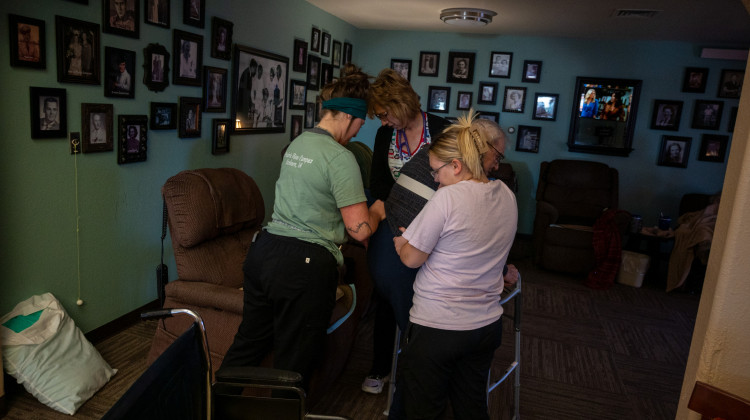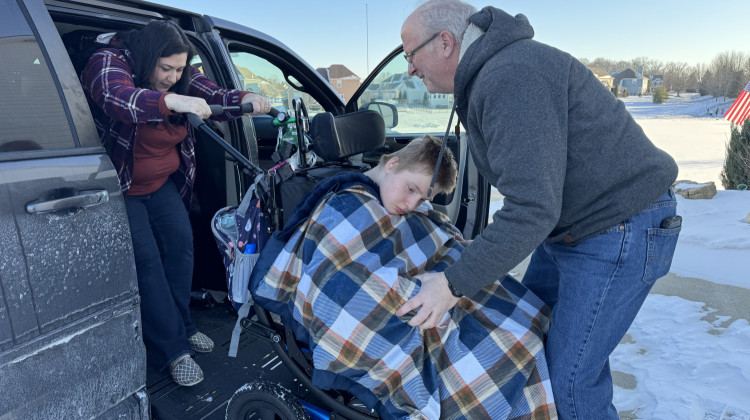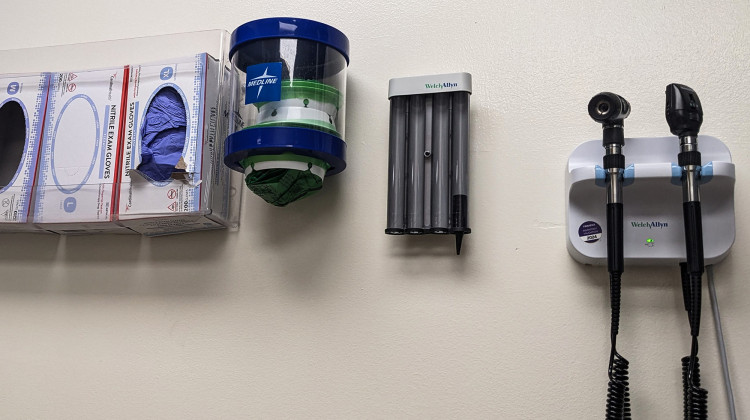
Employees at the Prairie View Nursing Home in Sanborn, Iowa, help a resident into a chair following lunch.
Natalie Krebs / Side Effects Public MediaAt the Prairie View skilled nursing home in Sanborn, Iowa, the cafeteria was noisy on a recent Thursday.
But not far from the sounds of conversation among dozens of residents is a unit that sits quiet and empty.
Wendy Nelson, Prairie View’s administrator, used a code on a keypad to enter into what used to be Prairie View’s memory care unit. A corkboard in the eating area still displays the date – February 22 – that the unit closed in 2022.
They closed it because they couldn’t find enough staff, Nelson, who’s managed the facility for nearly two decades, said.
“We were kind of in a situation where we had eight residents out of 16,” she said. “You have to have a nurse for the whole 24 hours. You have to have at least one to two aides for the whole 24 hours.”
Staffing is a chronic issue at Prairie View, and Nelson said it’s only gotten worse since the pandemic when many staff members burned out.
Many nursing homes like Prairie View across the country are facing critical staffing shortages, which can lead to dangerous conditions for residents and force facilities to limit the number of residents it can take. This fall, the Biden administration unveiled a controversial proposal that would create a staffing requirement, which has faced significant pushback from the nursing home industry.

Staffing shortages lead to serious issues
Prairie View maintains an eleven to one staffing ratio. It’s not a state or federal requirement, but Nelson said she believes it’s necessary so that residents get enough attention.
But this means with current openings, the nursing home –– one of the few in the rural area –– can only take 45 residents and is only at 60% capacity, Nelson said. In March of 2020, it was nearly full.
Nelson struggles to attract applicants even though she’s significantly bumped up pay for all positions from nursing to housekeeping –– up to $10 an hour. She knows it’s a hard job to work in a nursing home.
“You're able to go to Casey's [gas station], you know, and get paid pretty good nowadays, or McDonald's,” she said.
This summer, more than half of nursing homes across the country reported turning away prospective residents due to labor issues, according to a survey from the American Health Care Association, which represents nursing homes.
But staffing issues affect more than bed space for those who need high levels of care. When facilities don’t have the workers they need, studies show residents are more likely to receive poor, inadequate care.
To address these concerns, the Biden administration has proposed setting a minimum staffing level for nursing homes. This includes having at least one registered nurse on-site at all times and requiring employees to spend a minimum amount of time with each resident daily. These new measures would require more than 75% of nursing homes to hire additional staff. The requirement would be phased in.
Labor unions representing nursing home workers strongly support the proposed rules.
Other proponents, like senior organizations, say it will make nursing homes safer.
“We have seen time and time again, nursing homes that don't have adequate staffing, lead to serious problems when it comes to resident care,” Brad Anderson, the executive director of AARP Iowa, said.
‘A mandate is not going to create another single worker’
Last month, a group of Republican governors including those in Iowa, Nebraska, Missouri and Indiana sent a letter to the Biden administration urging it to reconsider the staffing requirement, echoing the concerns of the nursing home lobby.
“If adopted, [the Centers for Medicaid and Medicare Services’] proposed regulations will force many long-term care facilities in our communities to close, eroding access to health care for some of our most vulnerable citizens,” the letter said.
The long-term care industry lobby said the proposed measures will do more harm than good by requiring facilities to hire more staff who don’t exist.
The American Health Care Association estimates facilities nationwide will need to hire 102,154 additional full time workers under the mandate –– 80,077 nurse aides and 22,077 registered nurses.
“A mandate is not going to create another single worker, it simply creates a path to closure for more nursing homes who can't meet this mandate,” Brent Willett, the president and CEO of the Iowa Health Care Association, said.

Instead, lawmakers should focus on policies to help increase the workforce, he said.
“We should be talking about legal immigration reform. We should be talking about tax credits for health care workers, and other strategies to find ways to fund apprenticeship programs,” Willett said.
But some nursing home workers say they’d not only like to see the requirement in place, but also see facilities held more accountable for keeping staff properly trained and safe.
“Unless it's forced, it will not happen,” Savannah Hinze, a registered nurse who worked in nursing homes for a decade, said. “The nursing home world is a self-reporting body.”
Hinze said she loved working in long-term care because it was an environment where she could get to know her patients.
She left the industry several years ago and became a real estate agent because she felt the for-profit facilities where she had worked kept prioritizing their bottom line over patient care and worker safety.
It’s no surprise staff turnover is so high, she said.
“They're dealing with people who have dementia or strokes. These are adults who are physically strong, and the training isn't there,” Hinze said. “Instead of these companies investing in dementia training, they are just putting it elsewhere.”
She said she’d like to see policymakers make sure direct care staff get the support they need.
Side Effects Public Media is a health reporting collaboration based at WFYI in Indianapolis. We partner with NPR stations across the Midwest and surrounding areas — including KBIA and KCUR in Missouri, Iowa Public Radio, Ideastream in Ohio and WFPL in Kentucky.
 DONATE
DONATE







 View More Programs
View More Programs

 Support WFYI. We can't do it without you.
Support WFYI. We can't do it without you.